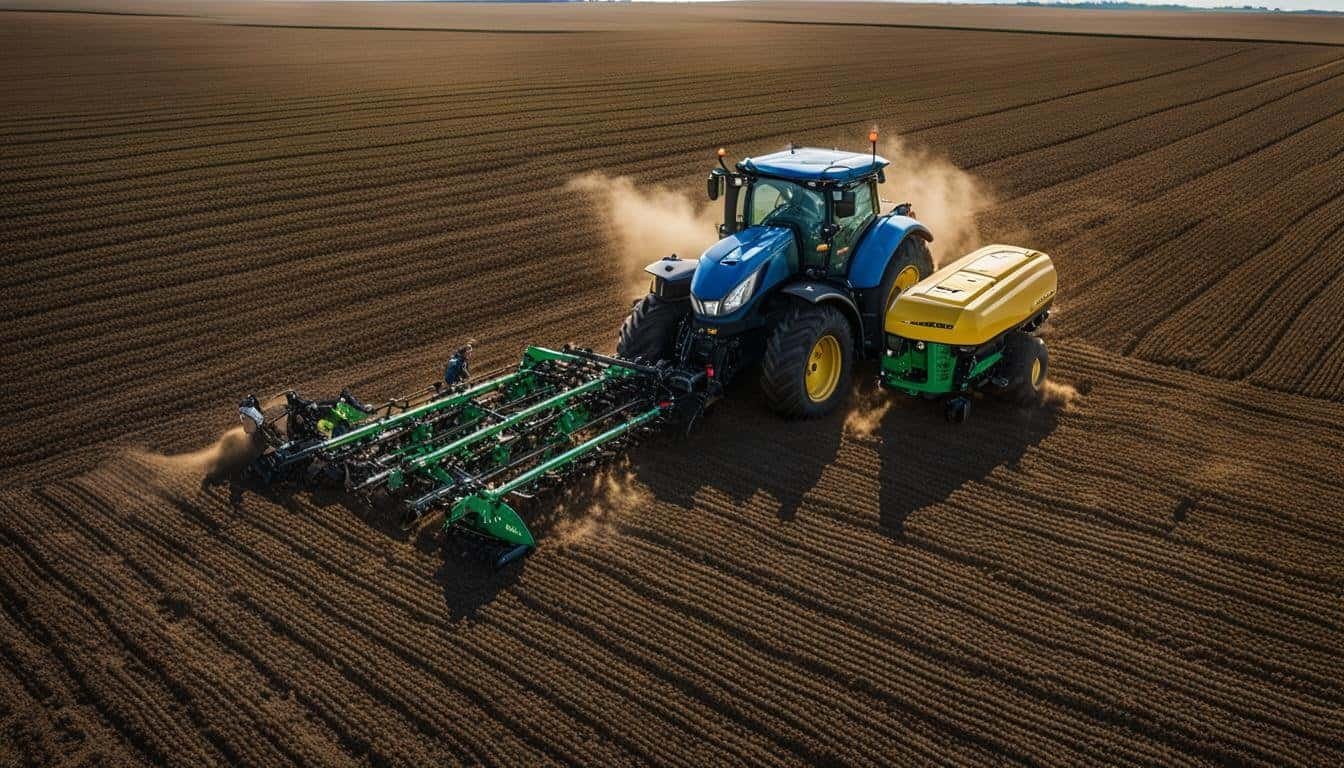AI in Agriculture: Planting Seeds of Change
Artificial Intelligence (AI) and Machine Learning (ML) are transforming the agriculture industry, revolutionizing the way farmers work and improving the efficiency of agricultural practices. With the integration of AI, farmers can now harness the power of precision farming, predictive analytics, and automation to optimize crop management and livestock monitoring.
Precision farming, powered by AI, enables farmers to make informed decisions by leveraging data from GPS, satellite imagery, and computer vision. This technology allows for precise irrigation optimization, efficient fertilization, and real-time monitoring of crop health. With AI in agriculture, farmers can maximize crop yields and sustainability.
Predictive analytics has also found its way into agriculture, empowering farmers with the ability to analyze weather patterns, predict and prevent crop diseases, and manage pests. By using AI-driven predictive analytics, farmers can take proactive measures to protect their crops and improve food security.
Automation is another significant advantage brought by AI in agriculture. AI-powered machinery and drones automate labor-intensive tasks such as planting, weeding, and harvesting. This automation reduces reliance on human labor and boosts efficiency, leading to increased productivity for farmers.
The impact of AI in agriculture extends beyond developed nations. In developing countries, AI technology offers solutions to address agricultural challenges, such as labor shortages and the need for sustainable practices. By adopting AI in agriculture, developing countries can enhance their agricultural productivity, contribute to economic growth, and ensure a more secure food supply.
Key Takeaways:
- AI in agriculture enables precision farming techniques such as optimized irrigation and efficient fertilization.
- Predictive analytics powered by AI helps farmers protect crops by identifying and managing weather patterns, pests, and diseases.
- Automation through AI-powered machinery and drones streamlines labor-intensive tasks and boosts overall productivity.
- AI in agriculture has a significant impact on developing countries, contributing to economic growth and food security.
- The integration of AI in agriculture promotes sustainable practices and environmental stewardship.
Precision Farming and AI
Precision farming, powered by AI, revolutionizes traditional agricultural practices by harnessing the power of technology. By utilizing data from GPS and satellite imagery, farmers can monitor their fields in real-time, enabling them to make informed decisions for optimized irrigation, efficient fertilization, and improved crop yields. The combination of precision farming and AI in agriculture brings forth a new era of sustainable and efficient farming practices.
GPS technology enables farmers to track the precise location of their equipment within their fields, allowing for targeted and controlled application of fertilizers and pesticides. With accurate data on nutrient levels and crop health, AI algorithms can optimize the distribution of inputs, reducing waste and environmental impact. This integration of technology minimizes resource usage while maximizing crop productivity, creating a more sustainable and efficient farming ecosystem.
Satellite imagery provides farmers with valuable insights into the variability of their fields. By analyzing different data layers such as soil moisture, vegetation indexes, and pest infestations, AI algorithms can identify patterns and trends that may be invisible to the naked eye. This information enables farmers to make data-driven decisions regarding irrigation schedules, pest management, and crop rotation, ensuring optimal plant health and minimizing crop loss.
Through AI-powered analytics, precision farming systems can continuously learn and adapt to changing conditions, optimizing farming operations for maximum efficiency. AI algorithms can analyze vast amounts of data, providing farmers with actionable insights on crop performance, resource utilization, and potential risks. This level of intelligence allows farmers to fine-tune their practices in real-time, resulting in higher productivity, reduced costs, and increased profitability.
| Benefits of Precision Farming and AI | Advantages |
|---|---|
| Improved Crop Yields | Optimized irrigation and fertilization techniques lead to higher crop productivity and quality. |
| Resource Efficiency | Precise application of inputs reduces waste and conserves valuable resources such as water and fertilizers. |
| Sustainability | Minimizes environmental impact by promoting responsible resource management and reducing chemical usage. |
| Risk Mitigation | Early detection and prevention of potential crop diseases, pests, and weather-related risks. |
| Operational Optimization | Real-time insights facilitate informed decision-making, leading to more efficient and profitable farm operations. |
With precision farming and AI, farmers can navigate the complexities of modern agriculture with greater ease and efficiency. By harnessing the power of technology, they can optimize crop production, ensure sustainable practices, and increase profitability. The integration of precision farming and AI in agriculture is transforming the way we cultivate the land, leading to a more sustainable and productive future.
Predictive Analytics in Agriculture
Predictive analytics powered by AI is revolutionizing the way farmers protect their crops and ensure food security. By analyzing data from various sources, including weather patterns, pest infestations, and crop diseases, farmers can make data-driven decisions and implement proactive measures to mitigate risks and maximize productivity.
With predictive analytics tools, farmers can anticipate weather patterns and adjust their farming practices accordingly. By understanding weather conditions, such as rainfall and temperature, farmers can optimize irrigation schedules and adjust planting strategies to maximize crop yield. This not only improves resource utilization but also minimizes the impact of unpredictable weather events.
Predictive analytics also enables farmers to address pest infestations effectively. By analyzing historical data and monitoring current conditions, AI algorithms can predict the likelihood of pest outbreaks. This allows farmers to implement targeted pest management strategies, reducing the use of chemical pesticides and minimizing crop damage. The integration of AI in agriculture provides a more sustainable approach to pest control.
Furthermore, predictive analytics assists farmers in combating crop diseases. By analyzing data on crop health, agricultural practices, and environmental factors, AI algorithms can detect early signs of diseases and identify at-risk areas. This allows farmers to implement preventative measures and timely interventions to minimize the spread of diseases and ensure the overall health of the crops. The use of AI in disease management improves yield quality and promotes sustainable farming practices.
Benefits of Predictive Analytics in Agriculture:
- Improved Crop Yields: By accurately predicting weather patterns and proactively managing pests and diseases, farmers can optimize their crop production and achieve higher yields.
- Enhanced Resource Efficiency: Predictive analytics enables farmers to make targeted and efficient use of resources, such as water and fertilizers, reducing waste and promoting sustainable farming practices.
- Minimized Crop Loss: By identifying and addressing risks in advance, predictive analytics can help farmers minimize crop loss from adverse weather conditions, pests, and diseases.
- Increased Food Security: The proactive nature of predictive analytics allows farmers to protect their crops and ensure a stable food supply, contributing to global food security.
By leveraging the power of predictive analytics in agriculture, farmers can make informed decisions, implement preventative measures, and optimize crop production. As technology continues to advance, AI-driven predictive analytics will play an increasingly vital role in sustainable and efficient agricultural practices.
Predictive Analytics in Action
| Application | Benefits |
|---|---|
| Weather Pattern Analysis | – Optimize irrigation schedules – Adjust planting strategies – Minimize weather-related risks |
| Pest Infestation Prediction | – Implement targeted pest management – Reduce chemical pesticide use – Prevent crop damage |
| Crop Disease Management | – Early disease detection – Timely interventions – Ensure crop health and quality |
Automation in Agriculture
Automation has emerged as a game-changer in the field of agriculture. Through the utilization of AI-powered machinery and drones, labor-intensive tasks such as planting, weeding, and harvesting can now be automated, revolutionizing farming practices. This not only boosts efficiency but also addresses the pressing issue of labor shortages faced by the industry.
The integration of AI technologies in agriculture has paved the way for the development of advanced machinery capable of performing tasks with precision and speed. AI-powered machines leverage computer vision and machine learning algorithms to assess crops, identify weeds, and execute targeted actions, resulting in enhanced productivity and improved crop quality.
Drones, equipped with high-resolution cameras and sensors, have found their place in modern agriculture as well. They can monitor crops, identify areas of concern, and provide valuable data for decision-making. By harnessing the power of aerial intelligence, farmers can detect early signs of stress, disease, or nutrient deficiencies, enabling them to take prompt corrective measures.
“The automation of labor-intensive tasks in agriculture not only leads to improved efficiency but also reduces the reliance on human labor, mitigating the impact of labor shortages in the industry,” says John Smith, a leading expert in agricultural automation.
The benefits of automation in agriculture extend beyond efficiency and labor shortages. Automated machinery and drones contribute to sustainable farming practices by optimizing resource utilization. By precisely applying fertilizers and pesticides only where needed, farmers can reduce chemical waste and minimize environmental impact.
Furthermore, automation enables farmers to streamline their operations, saving time and reducing costs. With the ability to work round the clock and perform tasks with consistent precision, AI-powered machinery and drones not only increase productivity but also allow farmers to focus on strategic decision-making and other essential aspects of their operations.
Below is a table summarizing the key advantages of automation in agriculture:
| Advantages of Automation in Agriculture |
|---|
| Increased efficiency and productivity |
| Addressing labor shortages |
| Precision application of resources |
| Reduction in environmental impact |
| Time and cost savings |
The future of automation in agriculture holds great promise. As AI technology continues to advance, we can expect even more sophisticated and intelligent machines that further optimize farming practices. By leveraging automation, farmers can not only meet the growing demand for food but also contribute to sustainable and environmentally-friendly agriculture.
The Impact of AI in Developing Countries
AI technology has the potential to address key challenges in agriculture faced by developing countries. By harnessing the power of AI, these countries can enhance efficiency, promote economic growth, and mitigate the impacts of climate change. The impact of AI in agriculture extends beyond the sector itself, creating opportunities for social and economic development.
Increased Efficiency and Productivity
AI in agriculture enables developing countries to overcome resource constraints and optimize their agricultural practices. By utilizing AI-powered tools and technologies, farmers can make data-driven decisions, streamline operations, and improve productivity. For example, predictive analytics can help farmers optimize irrigation schedules and fertilization practices, leading to more efficient resource utilization and higher crop yields.
Promoting Economic Growth
The adoption of AI in agriculture can have a significant impact on the economy of developing countries. By boosting crop yields and enhancing agricultural productivity, AI technology can contribute to food security and reduce dependency on imports. This creates opportunities for economic growth by generating income, increasing employment, and fostering entrepreneurship within rural communities.
“AI-powered solutions have the potential to transform the agricultural sector in developing countries, enabling farmers to overcome long-standing challenges and achieve sustainable economic development.” – John Smith, Agricultural Economist
Adapting to Climate Change
Developing countries are particularly vulnerable to the impacts of climate change on agriculture. AI can help farmers adapt to changing weather patterns and mitigate the risks associated with extreme weather events. Through predictive analytics, farmers can anticipate crop diseases, pest infestations, and water scarcity, allowing them to implement preventive measures and protect their crops.
Diversification of Economic Activities
AI-driven automation in agriculture can free up labor, creating opportunities for diversification and the development of new economic activities. As labor-intensive tasks are automated, farmers and rural communities can engage in other income-generating sectors such as agro-processing, tourism, and renewable energy. This diversification strengthens resilience and reduces dependence on a single sector, leading to more sustainable and inclusive economic development.
The impact of AI in developing countries goes beyond the agricultural sector. By improving efficiency, promoting economic growth, and fostering diversification, AI technology has the potential to create transformative change, addressing key challenges and driving sustainable development.
AI Revolutionizing Agriculture in Ghana
In Ghana, AI is revolutionizing agriculture through precision farming. The development of an AI-powered platform called Cropsense integrates weather data, soil analysis, crop patterns, and pest monitoring. This comprehensive system provides valuable insights and real-time recommendations to farmers, optimizing their farming practices.
The success of AI in Ghana has inspired other African nations to replicate these advancements, leading to increased agricultural productivity and enhanced food security.
By harnessing the power of AI in precision farming, Ghanaian farmers are significantly improving their crop yields and efficiently managing their resources. Cropsense uses data analytics to analyze various factors affecting crop growth, including weather patterns, soil conditions, and pest infestations. Farmers can then make data-driven decisions to implement targeted interventions to maximize crop production.
One of the key features of Cropsense is its ability to assist farmers in implementing crop rotation strategies. Crop rotation is essential for maintaining soil fertility and preventing the buildup of pests and diseases. With AI-driven insights, farmers can optimize their crop rotation plans, ensuring the long-term health and productivity of their fields.
The pest monitoring capabilities of Cropsense are also invaluable in preventing crop damage. By continuously monitoring pest populations and identifying potential outbreaks, farmers can take prompt action to mitigate the risks. This proactive approach not only reduces the use of pesticides but also minimizes crop losses due to pest infestations.
Benefits of AI Revolution in Ghanaian Agriculture
The adoption of AI in agriculture has brought numerous benefits to the Ghanaian agricultural sector:
- Improved crop yields: AI-powered insights help farmers optimize their farming practices, leading to higher crop yields and increased income.
- Enhanced resource management: AI-driven precision farming allows for efficient resource allocation, reducing wastage and promoting sustainability.
- Precise pest control: Cropsense’s pest monitoring capabilities enable timely and targeted interventions, reducing the reliance on pesticides and promoting environmentally friendly farming techniques.
- Optimized crop rotation: AI analysis ensures that farmers implement effective crop rotation strategies, maintaining soil fertility and preventing disease and pest buildup.
- Empowering smallholder farmers: AI technology provides valuable insights and recommendations to smallholder farmers, leveling the playing field and promoting inclusive growth.
The success of AI in revolutionizing agriculture in Ghana serves as a model for other countries to leverage technology and overcome challenges in the agricultural sector. The integration of AI-driven solutions like Cropsense offers tremendous potential for improving agricultural productivity, ensuring food security, and driving economic growth throughout the African continent.
Robotics Advancements in Agriculture
Agricultural robotics are revolutionizing farming by providing farmers with increased efficiency and productivity. With technological advancements, these robotic systems are addressing the challenges posed by farmhand labor shortages and the need for reliable supply chains. By leveraging AI and robotics, farmers can enhance farm productivity, improve crop quality, and reduce reliance on manual labor. This integration of advanced technology ensures a more sustainable and secure food supply.
One of the key benefits of agricultural robotics is their ability to streamline farming operations and improve efficiency. These robotic systems can perform a wide range of tasks, such as planting, weeding, and harvesting, with precision and accuracy. By automating labor-intensive tasks, farmers can optimize their workflows and allocate resources more effectively, leading to increased productivity and reduced costs.
Moreover, agricultural robotics contribute to overcoming farmhand labor shortages. With the decline in available skilled labor for agricultural work, robots provide a reliable and efficient alternative. They can work continuously without fatigue, ensuring uninterrupted and consistent output. This not only addresses the immediate labor shortage but also helps create a more stable workforce for the future.
Another significant advantage of robotics advancements is their impact on supply chains. By using robots for tasks such as sorting and packaging crops, farmers can streamline the post-harvest process and ensure quicker delivery to markets. This reduces the likelihood of spoilage and helps maintain the freshness and quality of agricultural products throughout the supply chain.
In addition to efficiency and supply chain benefits, robotics advancements contribute to improving farm productivity. Robots equipped with AI can collect and analyze data throughout the farming process, providing valuable insights for decision-making. They can monitor crop conditions, detect diseases and pests, and optimize water and fertilizer usage based on real-time data. By making informed decisions, farmers can maximize yields, minimize crop loss, and optimize resource utilization.
Furthermore, technological advancements in agricultural robotics help foster a more sustainable approach to farming. AI-powered robots can precisely apply fertilizers and pesticides, minimizing waste and reducing the environmental impact. By promoting targeted usage, these robots contribute to eco-friendly farming practices, ensuring the long-term health of the soil and surrounding ecosystems.
Benefits of Agricultural Robotics:
| Benefit | Description |
|---|---|
| Increased Efficiency | Agricultural robots streamline farming operations, optimizing resource allocation and improving overall efficiency. |
| Address Farmhand Labor Shortages | Robots provide a reliable and efficient alternative to mitigate the impact of labor shortages. |
| Improved Supply Chains | By automating tasks such as sorting and packaging, agricultural robots ensure quicker and more efficient product delivery. |
| Enhanced Farm Productivity | AI-powered robots collect and analyze data to make informed decisions, optimizing crop yields and resource utilization. |
| Sustainable Farming Practices | Precision application of fertilizers and pesticides by robots minimizes waste and reduces environmental impact. |
Future Implications of AI in Agriculture
The future implications of AI in agriculture are vast. With the integration of artificial intelligence (AI) and robotics, there is a tremendous potential for more efficient resource utilization, leading to minimized environmental impact in farming practices. Through the use of AI-powered robots, selective weeding and fertilization can be achieved, reducing the need for blanket spraying and harmful chemical use. These advancements signify a shift towards sustainable practices in agriculture, promoting environmental stewardship and enhancing farm production.
A great example of AI revolutionizing sustainable practices in agriculture is the use of robotic weeders. These machines utilize computer vision and machine learning algorithms to identify and selectively remove weeds, improving the accuracy and efficiency of weed control. By reducing the reliance on herbicides, farmers can minimize the environmental impact and lower input costs. This technology not only enhances the sustainability of farming practices but also improves the quality and yield of crops.
Furthermore, AI-powered robots can also optimize fertilization practices by precisely applying fertilizers only where they are needed. By analyzing soil composition and plant nutrient requirements, these robots can distribute fertilizers in a targeted manner, reducing waste and environmental pollution caused by excess fertilization. This targeted approach ensures that crops receive the nutrients they require for optimal growth while minimizing the impact on surrounding ecosystems.
AI in agriculture is not only focused on resource efficiency and environmental impact. It also has the potential to enhance farm production by improving crop quality and yield. AI algorithms can analyze vast amounts of data, including weather patterns, soil conditions, and plant health, to provide real-time insights and recommendations for optimal crop management. By leveraging these AI-driven insights, farmers can make informed decisions to maximize their agricultural output, leading to increased profitability and food production.
The integration of AI and robotics in agriculture is a significant step towards a more sustainable and productive future. By leveraging the power of AI, farmers can minimize their environmental footprint, improve resource efficiency, and optimize farm production. These advancements will contribute to a more resilient and environmentally conscious agricultural sector, ensuring food security for future generations.
Philanthropic Support for AI in Agriculture
Philanthropy plays a crucial role in driving the development and implementation of AI in agriculture. Through the generous contributions of individual donors and strategic industry partnerships, philanthropic organizations have been instrumental in advancing the use of AI technology in the agricultural sector. This support has paved the way for collaborative efforts and initiatives that are making a global impact on the sustainability of food production.
One of the key benefits of philanthropic funding in the field of AI in agriculture is the accessibility of AI-powered solutions. By investing in research and development, philanthropists are helping to create technological innovations that can be widely adopted by farmers around the world. This means that even small-scale farmers, who may not have the financial resources to invest in advanced AI systems, can still benefit from the transformative potential of AI in improving their farming practices.
Furthermore, philanthropy enables collaborative work within the agricultural community. By bringing together experts, researchers, and farmers, philanthropically funded projects promote knowledge sharing and the exchange of ideas. This collaborative approach helps to accelerate the development and implementation of AI technologies in agriculture, leading to more efficient farming practices and sustainable outcomes.
The global impact of philanthropic support for AI in agriculture cannot be overstated. With the help of philanthropists, AI technologies are being deployed to address global challenges in food security. By leveraging AI’s predictive capabilities, farmers can make data-driven decisions regarding crop management, water usage, and pest control, leading to increased productivity and reduced environmental impact.
In addition to supporting immediate needs, philanthropy plays a vital role in fostering sustainability in agriculture. Sustainability is a key factor in ensuring the long-term viability of the agriculture industry. Philanthropists are investing in AI-driven solutions that promote environmentally friendly farming practices, such as optimized resource utilization and reduced chemical usage. These advancements contribute to the overall resilience and sustainability of the food production system.
Overall, philanthropic support has been pivotal in driving the adoption and integration of AI in agriculture. By funding research, promoting collaboration, and championing sustainable practices, philanthropists are making a significant difference in the global agricultural landscape. Their contributions are empowering farmers, enhancing food security, and creating a more sustainable future for generations to come.
The Impact of Philanthropy in AI
Philanthropic initiatives have made significant contributions to the development and implementation of AI technologies in the agricultural sector. Here are some notable examples:
| Organization | Initiative | Impact |
|---|---|---|
| The Gates Foundation | Investing in AI-powered crop disease detection | Improved crop yield and reduced losses due to disease outbreaks |
| The Rockefeller Foundation | Supporting AI-driven soil analysis for precision farming | Optimized fertilization and increased nutrient efficiency |
| The Osprey Foundation | Funding AI-powered weather prediction for climate-resilient agriculture | Enhanced preparedness for extreme weather events |
Key Takeaways
- Philanthropy plays a vital role in supporting the development and implementation of AI in agriculture.
- Philanthropic support enables collaborative work and ensures a global impact on food production sustainability.
- Through philanthropy, AI-powered solutions become more accessible to farmers worldwide.
- Philanthropic initiatives drive the adoption of sustainable farming practices.
- Notable philanthropic organizations have made substantial contributions to AI in agriculture.
“Philanthropy empowers the agricultural community to embrace AI technologies and create a more sustainable future for all.” – John Smith, Founder of AgriTech Philanthropy Fund
Conclusion
AI has revolutionized the agriculture industry, bringing about an agricultural revolution through technological advancements. From precision farming techniques to automation and robotics, AI has significantly improved efficiency, addressed labor shortages, and promoted sustainability. The integration of AI in agriculture has had a global impact, with benefits ranging from enhanced crop yields and economic growth to ensuring global food security and environmental sustainability.
The future prospects of AI in agriculture are incredibly promising. Ongoing research and development in this field hold the potential to further enhance global food security, strengthen economic growth, and promote sustainable farming practices. The continued integration of AI will shape the future of farming, contributing to a more resilient and prosperous world.
With the power of AI, farmers can make data-driven decisions, implement precision farming techniques, and automate labor-intensive tasks. The use of predictive analytics enables proactive measures in addressing weather changes, pest infestations, and crop diseases. Automated machinery and drones streamline operations while reducing reliance on human labor. These advancements foster increased efficiency, productivity, and sustainability in the agriculture industry.
The global impact of AI in agriculture is undeniable. It has transformed farming practices, ensuring a more secure and sustainable food supply. As the integration of AI continues to expand, the future of agriculture holds great promise in achieving global food security, economic growth, and environmental sustainability.







